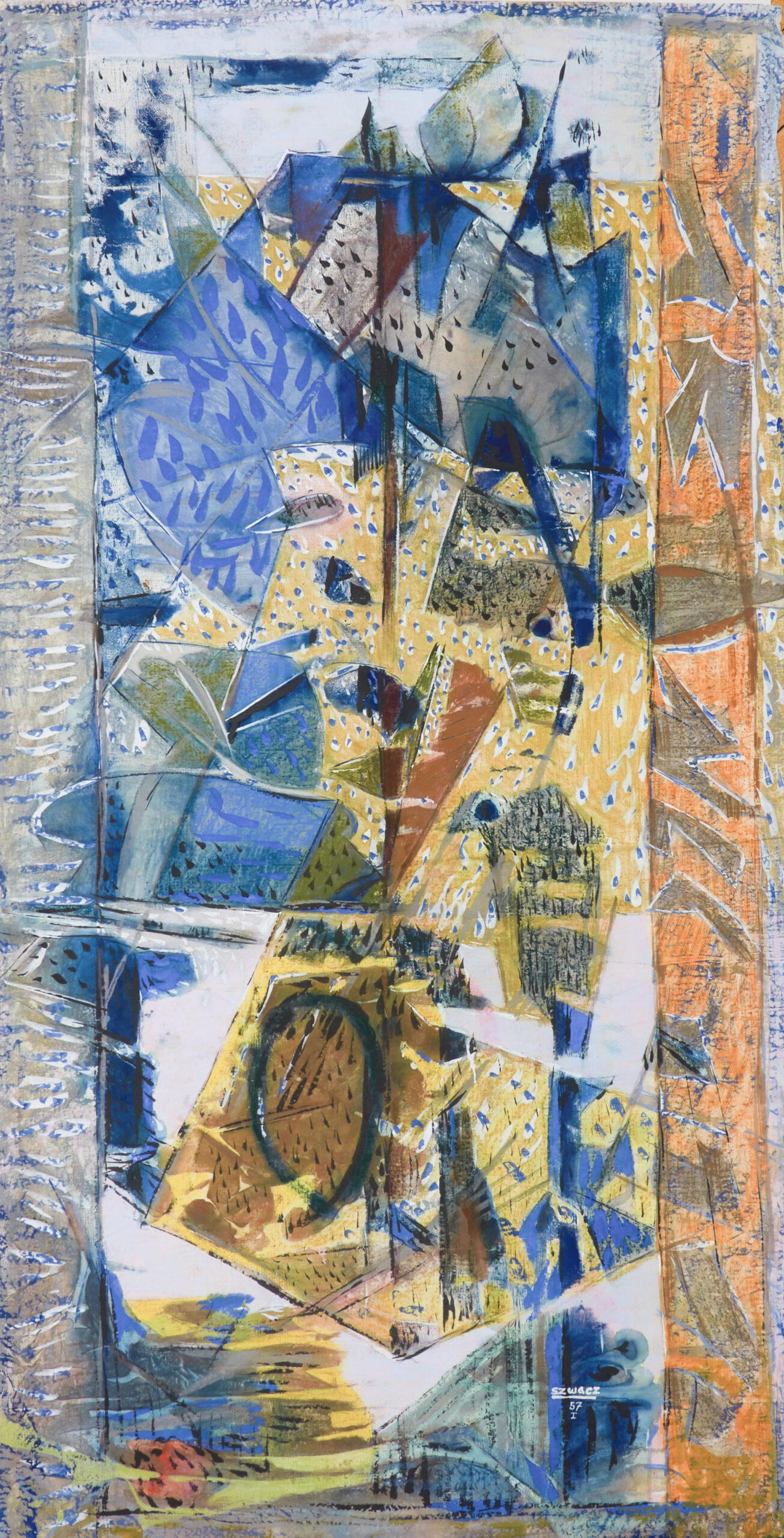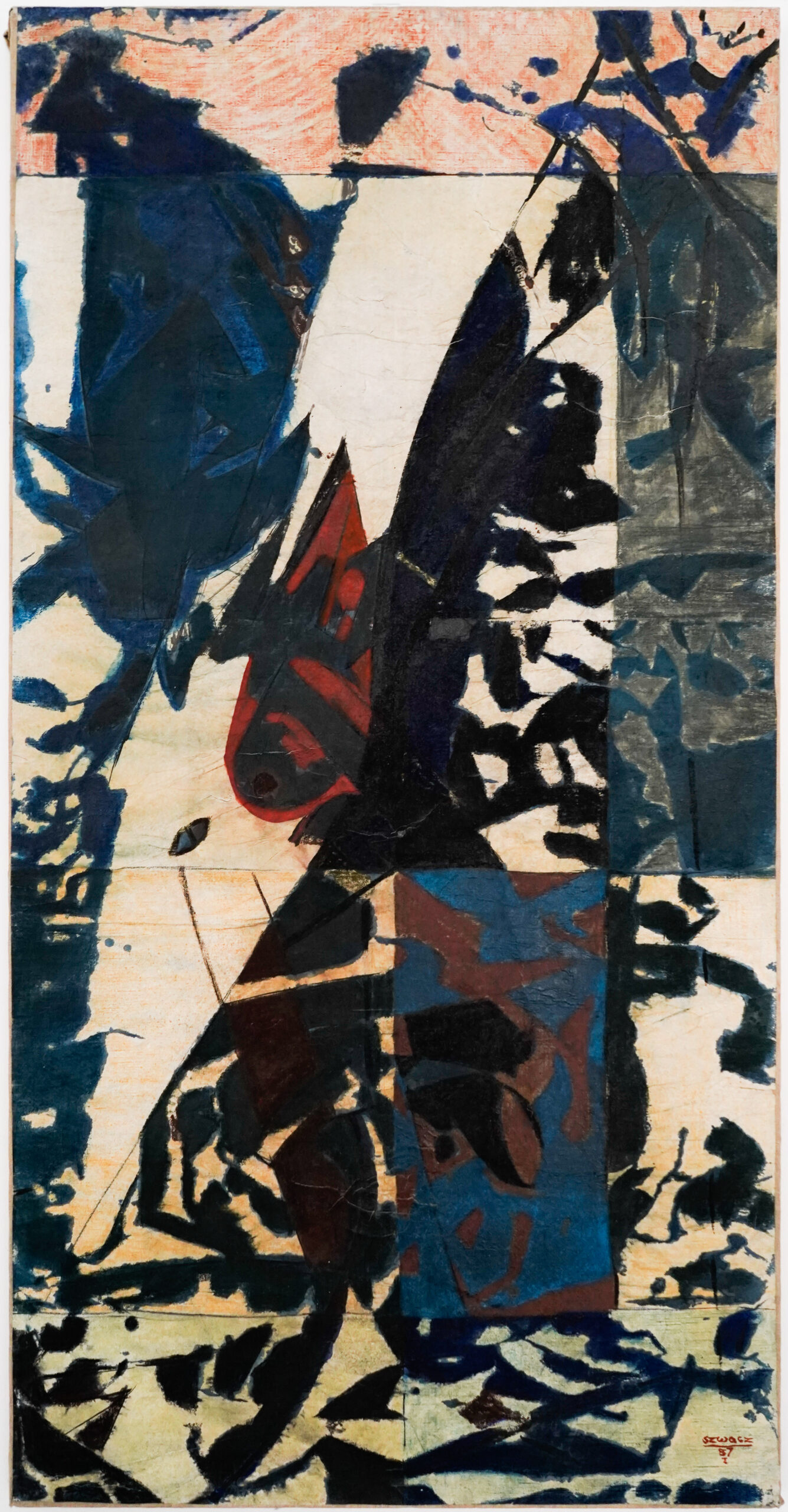Bogusław Szwacz
From modernity to contemporaneity
10.02-10.03.2022
In the studio of Bogusław Szwacz, an interesting collection of paintings has been kept, which – as far as we know – have never been exhibited, and are now being owned by the family. They are roughly 35 works made predominantly on paper, made by gouache, or the artist’s technique, often made in a monumental yet atypical format: 140 x 70 cm. Most of them have not been titled or bear only fragmentary titles, since they are limited to an ordinal number, and are not suggestive of any clues for interpretation.
All of them however come from the year 1957, which went down in history as the height of a brittle thaw in the field of visual arts the time of the unification of the 2nd Krakow Group, the period of stability for the running of Warsaw-based initiatives Grupa 55 and Krzywe Koło Gallery, and finally the starting point for the greatest spread of the Polish painting of matter, which was dominant at the most important exhibition of that time – the 2nd Modern Art Exhibition in the Zachęta Gallery in Warsaw.
There is no doubt, however, that for a large part of the artists of the era – including, undoubtedly, Szwacz himself – modernity was a formative idea, one that determined to the greatest extent their art and their attitude toward cultural policymaking. After the war, the artist was part of the modern milieu. He lived in Warsaw, but belonged to the Grupa Młodych Plastyków (Group of Young Visual Artists) (1946) and, taking advantage of the brief period of cultural policy favoring foreign travel, was on a scholarship in Paris, where he studied with Fernand Léger (1947-1948) and had contact with the group Le Surréalisme Révolutionnaire. Such artistic orientation is of great importance. And it was Léger who was – next to Picasso – the most significant determinant of modernity, soon enriched by the surrealist impulse flowing to both Polish centers simultaneously from France and the Czech Republic.
Szwacz believed that the artistic means at the artist’s disposal should reflect the socio-cultural changes taking place before his eyes. All works on paper from 1957 feature shallow spaces organized by expressive painterly gestures that give character to the whole, but beyond this basic similarity, one must rather point to a catalog of differences and parallel directions of enquiry. Many of the works are constructed with black lines and clear color divisions. Some are more mosaic-like, others more synthetic. Relating them to each other, it becomes clear that they also use a wide variety of color ranges: from dark, impenetrable, and evocative of solemnity to warm and cheerful, gently spilling over the surface. And this whole range of means oscillates between two modes of representation: although abstraction dominates almost without exception, suggestions of very synthetic figuration breakthrough here and there.
This is the case with the gouache which against a bright ochre-yellow background depicts a dark silhouette of a man holding a flag perched on a long pole. The line of the rod runs through the entire composition, touching a brown patch filled with decorative hatching at the bottom. Is it some piece of land, as the flag would indicate, or is it, however, the outline of a fur-covered animal, and the scene is not the act of conquering a new land, but a hunt?
Szwacz plays with the viewer, or rather with himself, if one remembers that the papers remained in the studio. He offers no answers, does not outline a clear path. One can say that the imagined explorer of new lands is himself – the artist allowing himself to lack any orthodoxy and unhurriedly explore potential directions of development.
Just as modernity is fluid and in constant evolution, art practice proves to be equally processual. It remains open to “a space in which a free play of associations, colors, and forms can take place” a space of abstract experiment conducted under the cover of art’s autonomy. If this artistic credo applies to Szwacz’s entire oeuvre from at least the second half of the 1950s, then one might conclude that the 1957 studio cartons adhere particularly well to this creed: unorthodox, diverse, open to error and correction – the best examples of a creative practice that does not follow the course of history, but slowly recognizes its possibilities, without a set goal or predetermined plan.
Works
| Status | Title | Year | Technique | Dimensions | |
|---|---|---|---|---|---|
| Loading… |

|
Composition | 1957 | mixed media on paper | 140 x 70 cm |
| Loading… | Composition | 1957 | mixed media on paper | 140 x 70 cm | |
| Loading… | Composition | 1957 | mixed media on paper | 130 x 70 cm | |
| Loading… |

|
Composition | 1957 | mixed media on paper | 140 x 70 cm |
| Loading… | Composition | 1957 | mixed media on paper | 140 x 70 cm | |
| Loading… | Composition | 1957 | mixed media on paper | 140 x 70 cm | |
| Loading… |

|
Composition | 1957 | mixed media on paper | 140 x 70 cm |




